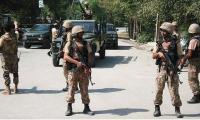Both poverty and hunger are on the rise as the result of heavy monsoon rains and floods which not only washed away crops, homes and livestock but also livelihood, hopes and dreams of millions of people. If people were poor before the floods now they are below the poverty line.
Pakistan’s economy was facing many problems before the widespread devastation caused by the floods. The floods have further aggravated the worsening economic situation. The economic crisis before the floods hit millions of poor and working people very hard, the historic high inflation and falling real incomes making the lives of working people and poor communities miserable. Low growth and high inflation is a killing combination for the poor and vulnerable of society.
The agriculture sector has been hit the hardest by the floods. Just take the example of the rice crop. Pakistan exported $2.5 billion worth of rice in 2021-22 and earned much needed foreign currency reserves. But the floods have destroyed the rice crop in Sindh, the province losing nearly 80 per cent of its crop.
Sindh produces 42 per cent of Pakistan’s rice production. The flood havoc has resulted in the estimated loss of 1.9 million tons of rice, equivalent to an 80 per cent loss of the province’s forecast rice production. This means, Pakistan will export less rice this year and earn less foreign reserves.
The agriculture sector was already in crisis before the floods. Pakistan has failed to modernize agriculture production and increase per acre yield compared to other countries. Pakistan was a net exporter of cotton, wheat and rice but in the last few years, Pakistan has become a net importer of wheat, cotton and other agricultural products.
Nearly 70 per cent of Kharif crops in Sindh have been destroyed by the torrential rains and flash floods, with farmers incurring losses worth Rs350 billion as a result of flash floods. Small farmers, landless peasants, daily wage labourers and agriculture workers have been badly affected. The agriculture crisis will make their lives more miserable. The devastating floods have created a situation in which poverty and hunger will increase.
So it is not surprising that two reports on rising poverty and hunger have come out in the last few days. A World Bank report and a report by Save the Children have both warned Pakistani authorities and policymakers that millions of flood affected people are likely to fall into poverty and face hunger as a result of the recent floods. Both reports paint an alarming situation for the coming days if the government fails to help flood victims.
Let’s start with the World Bank report. The World Bank has predicted just two per cent GDP growth during the current financial year 2022-23. That means GDP growth would be lower than the growth of population. Low growth means fewer jobs, high unemployment, falling incomes and rising poverty. This clearly means a tough and challenging year for working people and the poor.
In its October 2022 ‘Pakistan Development Update: Inflation and the Poor’, the World Bank has stated that: “the slower growth will reflect damages and disruptions caused by catastrophic floods, a tight monetary stance, high inflation, and a less conducive global environment. Recovery will be gradual, with real GDP growth projected to reach 3.2 per cent in fiscal year 2024.
Poverty in the hardest-hit regions will likely worsen in the context of the recent flooding. Preliminary estimates suggest that without decisive relief and recovery efforts to help the poor, the national poverty rate may increase by 2.5 to 4 percentage points, pushing between 5.8 and 9 million people into poverty.
Macroeconomic risks also remain high as Pakistan faces challenges associated with a large current account deficit, high public debt, and lower demand from its traditional export markets amid subdued global growth.
The recent floods are expected to have a substantial negative impact on Pakistan’s economy and on the poor, mostly through the disruption of agricultural production,” says Najy Benhassine, the World Bank’s country director for Pakistan. The second report is a research conducted by Save the Children. According to this research, more than 3.4 million children in Pakistan are facing chronic hunger. Nearly 76,000 children in flood-hit areas are now experiencing severe food shortages and risking severe malnutrition.
Save the Children says that the number of people going hungry has soared in Pakistan by an alarming 45 per cent since the floods wreaked havoc across much of the country, rising from 5.96 million people to 8.62 million, the majority of them in the flood-affected regions. The report warns that “Hunger levels are expected to rise further with the onset of winter, putting millions of young lives at risk if urgent action is not taken.”
The report highlights that floods have devastated crops and livestock and, with goods scarce, prices have spiked. The cost of basic food items has also soared since the floods, making them unaffordable for many families who are living on next to nothing after losing their homes and incomes.
Save the Children has pointed out that families are resorting to desperate measures to survive, going into debt or selling what little they have left to buy food, relying on charity, or sending their children to work.
The situation is desperate for millions of people. They need livelihood to survive. The government should pump out the waters from fields so the farmers can prepare their lands for upcoming crops. Farmers need cheap seeds, electricity, fertilizers and fuel on subsidized rates to cultivate their lands. They need cheap loans and other incentives to rebuild their lives.
The writer is a freelance journalist.
Earth Day protests carry a vital message that is relevant 365 days a year. — AFP File Earth Day is celebrated every...
People walk along a market in Lahore on May 17, 2023. — AFP/FileMany of us had hoped that the general election...
Packs of freshly printed $20 notes are processed for bundling and packaging at the US Treasury's Bureau of Engraving...
People stand in line up as election officials check their ballot papers during voting general election at a polling...
Women show their voter identity cards as they stand in a queue before casting their votes in Agartala. — PTIThe 18th...
Former prime minister Imran Khan. — Instagram/ imrankhan.ptiAn old saying has it that “when you dance with the...







